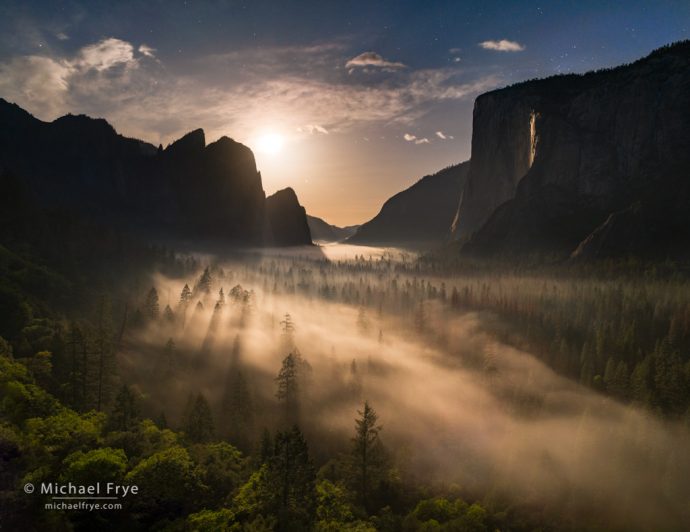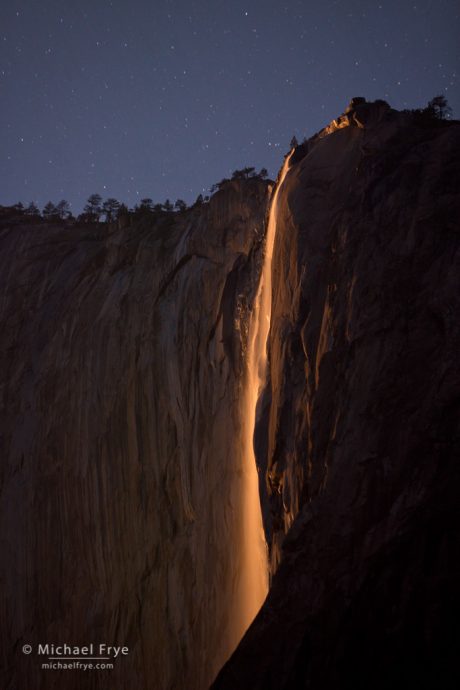Every year, around the third week of February, the sun sets at just the right angle for Horsetail Fall. With clear skies and enough water, the backlit waterfall glows with a brilliant orange color, lit by the setting sun.
Some years ago it occurred to me that the setting moon could create the same effect. In the spring of 2010 I had a chance to try this, and it worked beautifully. As I wrote back then, I walked up to one of my favorite Horsetail Fall viewing locations early in the morning, and saw an amazing sight: that beautiful, low-angle backlight on the waterfall, with the cliff behind it in the shade. It looked like sunset in February, only with stars in the sky above it. And the camera captured what my eyes couldn’t see – the orange glow created by the setting moon:
There have been few opportunities to try this again. Mainly that’s due to the drought, but also because the moon rarely reaches the right position. This year we had a near-record snowpack in the Sierra, and Horsetail Fall kept flowing late into the spring. But there was no time when the moon would set at the same angle as it does in late February — at least not during the night, before Horsetail stopped flowing. (There were dates when it would set at the right angle, but during the day, which obviously wouldn’t work.)
But there was one date when the moon would set at night just a little further north, similar to the sunset angle in early March. That’s not ideal light for Horsetail, but I thought I might try it if conditions were right. On the night I had picked out some clouds moved through, but it looked like skies were clear enough to give it a try, so I drove up to Yosemite during the wee hours of the morning. I made my way through a moonlit forest to a spot overlooking the west end of the valley, and found mist along the valley floor. This was a pleasant surprise, since I hadn’t seen any mist on the drive into the valley.
I quickly composed, focused, and made a series of bracketed exposures. To get the mist and Horsetail Fall in the frame I had to include the moon itself, and risk getting lens flare, but luckily a thin band of clouds dimmed the moon a bit and minimized the flare.
I kept photographing for another 45 minutes as the moon sank, and the mist shifted, dissipated, and reformed along the valley floor. As I expected, the light left Horsetail Fall well before moonset, so I never captured that intense orange glow on the fall. But the mist more than made up for that. It turned out the the very first sequence I captured was the one I liked best, with the most interesting mist. I blended three of my bracketed exposures together manually in Photoshop, using layer masks, in order to get detail in both the foreground and the sky.
Last February, from a nearby spot, I saw perhaps the most amazing sunset I’ve ever witnessed. It would be hard to equal those conditions, but I like this moonlit image too, for different reasons. The mist was a beautiful, unexpected bonus.
— Michael Frye
Related Posts: Horsetail Fall by Moonlight; A Surreal Sunset
Michael Frye is a professional photographer specializing in landscapes and nature. He is the author or principal photographer of The Photographer’s Guide to Yosemite, Yosemite Meditations, Yosemite Meditations for Women, Yosemite Meditations for Adventurers, and Digital Landscape Photography: In the Footsteps of Ansel Adams and the Great Masters. He has also written three eBooks: Light & Land: Landscapes in the Digital Darkroom, Exposure for Outdoor Photography, and Landscapes in Lightroom: The Essential Step-by-Step Guide. Michael has written numerous magazine articles on the art and technique of photography, and his images have been published in over thirty countries around the world. Michael has lived either in or near Yosemite National Park since 1983, currently residing just outside the park in Mariposa, California.











Just gorgeous shots, Michael. Can you put me in your backpack and take me along next time? 😉
Sure Greg – how much do you weigh? 🙂
Beautiful…and what’s your favorite spot to get this view????
Thanks Vishal! Please see the P.P.S. here:
https://www.michaelfrye.com/2017/02/26/surreal-sunset/
Stunning, Michael! It’s almost otherworldly, how the mist is draped over the land with the moon creating shadows that lean toward us viewers. I see the lit falls as an added bonus, with the mist being the real draw, for me, anyway. Really beautiful!
Thanks so much Todd!
Now THAT valley shot is magically beautiful, done right from start to finish. Perfection.
Thanks so much Jeff!
That moonset and valley fog is exquisite!
Thank you Cory!
Michael I love your work,really amazing photos. A lot of people including myself would really like to know the camera, lens and settings that were used for your photos. Why are they never included with your photos?
Thanks very much Bill. As for settings, I do include those pretty often when it seems relevant. Regarding the camera and lens, I guess I don’t think those are important. There so many photography blogs and websites out there that are focused on gear, gear, gear. I’d like to get away from that. Gear is so unimportant. I see many websites where the caption always lists the make and model of camera and lens, and I wonder why. Is that important or even useful information? We photographers complain when some non-photographer compliments one of our photos, and then says, “You must have a really great camera” – as if the camera took the photo, not the photographer. But then we insist on endlessly discussing gear amongst ourselves. I think if the average photographer spent half as much time thinking about composition as they do about gear they could make much better photographs. My wife Claudia makes better photos with her iPhone than most people do with their expensive DSLRs. Why? Because she understands composition. Seriously, check out her Facebook profile:
https://www.facebook.com/claudia.welsh
Michael,. Your work is inspiring. Your one of the few that avoid discussion on gear…This is refreshing! Your absolutely correct the gear does not matter. Once you have a camera that does what you need, there is no point in chasing new , better bodies or that new lens that is sharper than the last version. Focus on making photos! Keep up the great work
Nelson It isn’t necessarily a discussion about gear in general. I think a lot of amateur photographers who admire someone’s work would be interested in his equipment and the exposure settings.
Bill – that’s your opinion. My opinion is also valid.. folks place way too much emphasis on camera gear and forget photography is about light, composition and how you see the world around you.
I think the reason some photographers won’t talk about their gear is, if they don’t mention their gear more emphasis is placed on the photographer. Photography is about light, composition and how one interprets the world; the photographer and his skill and artistry is number one although ya gotta admit it also helps to have quality gear and knowledge in editing software. Photography is a whole package of several factors, not just one.
Quality gear is almost any camera these days. You could have a 100mpx medium format camera , and still have crap photos. It’s about knowing your craft. Learning to see, studying light and composition… And most importantly getting out there to make photos!
Your right Michael Frye certainly knows his craft, has studied light and composition and yes he gets out and takes a lot of photos; he is a very talented photographer, his photos are top notch. I agree knowing your craft is very important although I don’t think he could duplicate his photos using a cheap cell phone camera and no editing software.
I wasn’t talking about cell phone cameras. Although, Michael Frye himself admitted his wife can take better photos with her iPhone than some folks with expensive DSLRs. If someone gets into photography thinking their gear will make them great… Well they’re in for big disappointment. You can have a sharp photo but if the concept is fuzzy…well enough said
Bill and Nelson, thanks for sharing your thoughts on all this; a very interesting discussion. I don’t mind talking about gear when it seems relevant. And you do need the right tools for the job, so gear is important – I just don’t think it should be front and center all the time.
For what it’s worth, I use a Sony A7r II for all my photos. And therein lies another reason why I don’t automatically list my equipment – because the right camera for me is not the right camera for most other people. I love the A7r II, and it works really well for my needs, but most people don’t need that much resolution. Plus, not everyone is going to like the electronic viewfinder, and, if they’re accustomed to a Nikon or Canon DSLR, they will struggle for awhile to get used to the very different controls and menus on the Sony.
For most photographers, familiarity with their camera’s controls is far more important than the camera’s actual performance. If you’re constantly struggling to remember which dial to turn or button to push, you can’t concentrate on the light or composition. Yet I’m constantly surprised by how many people think that because Michael Frye uses it, they should buy the same camera. Everyone has different needs, and the camera you choose should fit your needs, not mine.
Michael
I agree with your comments. I’ve been a hobbyist for a good 10 years now, and initially I thought (like most beginners) that a better camera would get me there faster. I started with an entry level Canon rebel.. eventually moving up to a mid range Nikon full frame…and now a Sony A7Rii (yes I own the same camera you have). Point is, never did any camera or lens upgrade improve my photography. It was the hard work…learning to see, studying composition and the role of lighting that made a real difference.
Granted I think a better camera has its place but only when it is not meeting your requirements… Maybe it’s low light capability isn’t good enough, or maybe you need more resolution…or better controls and ergonomics. These are things that CAN impact your vision because they become a hindrance in the field. A camera is a tool to a photographer like a chisel is to a sculpture.
Keep up the fantastic work Michael.
I was looking for inspiration as I am heading to Yosemite next July and found your work. I will admit I have heard your name before and I am so glad I came to see your work! 🙂
You are right about gear not being super important. I have also seen many people too concerned about the gear they need to create their photos.
Thanks so much for your inspirational work.
Thank you Juan Carlos!
Thanks Michael for the input, very interesting bit of information and I totally agree with your comments. I am a total amateur with a new Nikon dslr and I can tell it will take me a while to become familiar with everything on it. I would give anything to live where you live, its a photographer’s paradise. If I lived closer I would also be able to attend one of your workshops. I love your work, your truly a master of landscape photography and an inspiration to me. Thanks . Oh by the way I recently bought your pdf book on exposure, nice work full of good information. Landscape in lightroom is on my list.
Nelson, enjoyed our conversation, keep your chisel sharp and your finger on the shutter release.
Same here Bill … Just keep shooting! 🙂